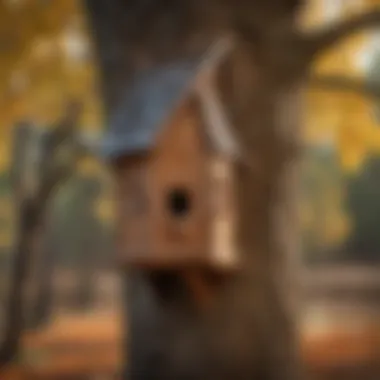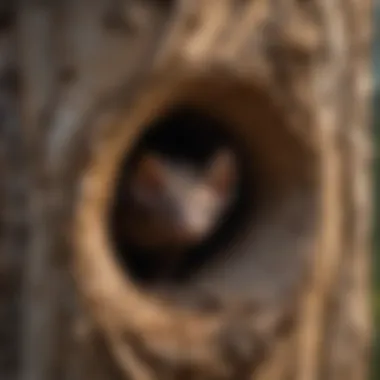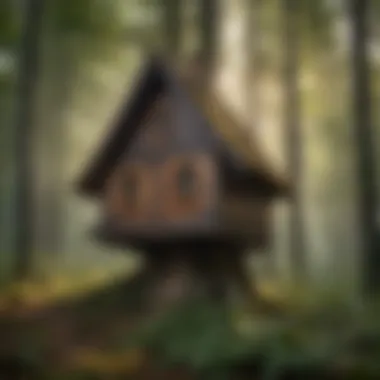The Best Bat House: A Comprehensive Guide


Intro
Bat houses serve a crucial function in our ecosystems, particularly in woodland areas. Appreciating how bats contribute to biodiversity is fundamental for understanding their importance. This guide seeks to unravel the layers of knowledge required to construct effective bat houses while emphasizing their ecological relevance.
In many regions, bat populations face threats due to habitat loss and environmental changes. Addressing these issues involves not just creating bat houses but also comprehending broader ecological concepts. Herein lies the dual purpose of this article: to furnish you with the essentials of bat house construction and maintenance, while also enlightening you on the intricate role bats play in forest health.
Understanding Woodland Ecosystems
Importance of Biodiversity in Forests
Biodiversity within forests sustains the delicate balance of life. It encompasses the variety of species, their genetic variation, and the ecosystems they inhabit. Bats, as diverse creatures, are integral to this complexity. They contribute to insect population control, pollination, and seed dispersal. Protecting these flying mammals means preserving the diverse web of life they support. Many species of bats rely on specific habitats, and the loss of these areas can disrupt local ecosystems.
Role of Forests in Climate Regulation
Forests play a significant role in climate regulation. Trees absorb carbon dioxide, thus mitigating climate change effects. Bats also contribute to this process by preying on insects, a task that prevents pest overpopulation, which can have cascading effects on plant health. Furthermore, healthier forests can sustain larger bat populations, creating a beneficial cycle of preservation.
"Healthy ecosystems benefit from diverse species, and bats are among the unsung heroes of our woodlands."
Sustainable Forestry Practices
Principles of Sustainable Forestry
Sustainable forestry principles emphasize practices that meet current ecological, social, and economic needs while ensuring future generations can do the same. Key principles include:
- Maintaining forest health and biodiversity.
- Promoting natural regeneration.
- Minimizing environmental damage during management operations.
Case Studies of Successful Implementations
Examining forest management projects can provide insights into successful sustainable practices. For instance, the Great Smoky Mountains National Park implemented strategies for monitoring bat populations and their habitats. The results demonstrate how responsible forestry can benefit both timber production and wildlife conservation.
Woodland Stewardship Techniques
Forest Management Plans
A detailed forest management plan serves as a roadmap for landowners. It outlines objectives, strategies, and methods to maintain or improve the health of woodlands. Including bat conservation in these plans is essential, as it helps ensure that specific habitats critical to bat survival are preserved and enhanced.
Conservation Strategies
Conservation is an active approach that includes various strategies:
- Habitat restoration: Revitalizing areas where bat populations have declined.
- Public education: Promoting awareness among local communities about the importance of bats.
- Policy advocacy: Supporting legislation that protects bat habitats.
By integrating these techniques within woodland stewardship, we can bolster the resilience of bat populations and, by extension, the ecosystems they inhabit.
Understanding the Ecological Role of Bats
Bats play a crucial role in various ecosystems, particularly in woodlands. Understanding this ecological role is essential for anyone interested in promoting biodiversity and maintaining healthy forest environments. Bats are not just creatures of the night; they actively contribute to processes that help to sustain their habitats. Their presence can enhance ecological balance, reduce pest populations, and facilitate plant reproduction. Thus, when considering bat houses, one must recognize that these structures serve a much larger purpose than merely providing shelter.
Bats and Their Importance to Ecosystems
Bats are among the most diverse groups of mammals, with over 1,400 species worldwide. They occupy several ecological niches and perform numerous functions. For instance, insectivorous bats consume vast numbers of insects each night. A single bat can eat up to 1,000 mosquitoes in just one hour. This natural pest control helps maintain healthy environments and reduces the need for chemical pesticides, which can be harmful to plants and other creatures.
Furthermore, bats contribute to maintaining the delicate balance within ecosystems. Their dietary habits ensure that certain species do not dominate, thereby preserving the diversity of the fauna.
Impact of Bats on Insect Populations


The impact bats have on insect populations cannot be overstated. Bats are critical predators of insects, including agricultural pests that can damage crops. A study labeled their contribution as invaluable to agriculture, estimating that bats save the farming industry billions of dollars each year through their predation. The presence of bats in agricultural areas can result in a noticeable decrease in insect populations, leading to healthier crops and reduced reliance on chemical pesticides.
The reduction in harmful insects also benefits other wildlife and plant species that can suffer from overpopulation of specific insects.
The Role of Bats in Pollination and Seed Dispersal
Bats are also important pollinators, especially in tropical regions. Certain species, like the fruit bat, are responsible for pollinating many plants, including mangoes and bananas. These bats have adaptations, such as long snouts and tongues, that allow them to reach nectar deep within flowers. As they feed, they transfer pollen from one flower to another, facilitating the reproduction of plants and contributing to the overall health of the ecosystem.
Additionally, bats assist in seed dispersal. Many fruit-eating bats consume fruit and later excrete the seeds far from the parent plant. This not only aids in the spread of various plant species but also helps maintain genetic diversity.
In summary, bats are vital organisms within woodland ecosystems. Their roles in pest control, pollination, and seed dispersal illustrate their ecological importance. By ensuring their survival, we support a healthier environment.
Understanding the ecological role of bats enhances the justification for installing bat houses. Their conservation contributes to overall biodiversity, thus benefiting both forested areas and agricultural landscapes.
What Constitutes the Best Bat House
Understanding the elements that make up the best bat house is crucial for woodland enthusiasts aiming to foster bat populations. An effective bat house not only provides shelter but also addresses the specific requirements of bats, enhancing their likelihood of occupancy. The importance of thoughtful design cannot be overstated. A well-constructed bat house will encourage species diversity, contribute to local ecosystem health, and help maintain natural pest control.
Key Features of an Effective Bat House
An effective bat house possesses several key features that cater to the needs of bats. Firstly, it should ensure proper ventilation. Adequate airflow helps maintain a suitable temperature inside the house, preventing overheating during the warmer months. A well-ventilated structure is likely to attract more bats seeking a suitable roosting location.
Secondly, a sturdy and secure design is necessary. Bats require shelter from predators and harsh weather, so the design must be robust enough to offer protection. Furthermore, the entrance size should be suitable for the species intended. Designing an entrance that is neither too large nor too small will prevent larger predators from accessing the house.
Moreover, the interior texture of the bat house should not be overlooked. A rough surface provides bats with the grip they need for landing and roosting. Smooth surfaces hinder their ability to cling, making the house less suitable for habitation.
"A bat house must cater to both the biological and environmental requirements of bats to be considered effective."
Materials: Choosing the Right Wood
Selecting the appropriate materials is essential when constructing a bat house. Cedar and pine are generally the best options. Cedar wood has natural rot-resistant properties, which can prolong the lifespan of the bat house. Pine, when treated appropriately, can also serve. Avoid using pressure-treated wood, as it may emit toxic chemicals harmful to bats.
In addition to wood type, consider the thickness of the material. Thicker walls provide better insulation, helping to regulate internal temperatures. This is particularly important in regions with extreme temperature variations. A house that is too cold in winter or too hot in summer will deter bats from settling.
Size and Dimensions for Optimal Use
The size and dimensions of a bat house play a significant role in its functionality. Generally, a bat house should be at least 24 inches tall by 12 inches wide to accommodate a variety of bat species effectively. The interior chambers should be designed to allow for multiple roosting options, preferably with a depth of 4-6 inches.
Furthermore, houses designed for colony species should have sufficient chambers, allowing for social behavior among bats. For solitary species, a smaller house limited to a few chambers may suffice. An optimal design will take into account the specific bat species in the area, tailoring dimensions accordingly for the most effective use.
Designs: Various Types of Bat Houses
Understanding designs for bat houses is critical in creating effective habitats for bats. Each design serves a specific purpose and caters to different species of bats. When deciding on a bat house, consider aspects such as the amount of space needed, the species you aim to attract, and how you wish to engage with the bat population. This section will delve into three primary designs: Single-Chamber Bat Houses, Multi-Chamber Bat Houses, and Bat Houses with Observation Features.
Single-Chamber Bat Houses
Single-chamber bat houses are the most straightforward design option. They usually appeal to solitary bats or small groups. This type of house is typically designed for easy construction and minimal material use. An advantage is that they require less space and can be mounted in various locations, making them suitable for small gardens or patios.
The essential features of single-chamber bat houses include:
- A narrow body to provide a snug fit that helps bats feel secure.
- Ventilation openings to regulate temperature.
- A rough interior surface to aid bats in climbing.
While this design is easy to make, it may not suffice for large bat colonies. Thus, if you plan to attract a significant population, this may not offer enough space.
Multi-Chamber Bat Houses
Multi-chamber bat houses provide ample space, making them ideal for larger bat populations. These structures often include multiple compartments, allowing more bats to roost together. This design not only improves species attraction but also increases the chances of sustaining a breeding population.


Key benefits of multi-chamber bat houses include:
- Accommodating different species that prefer varied roosting conditions.
- Enhanced community dynamics, as bats in groups can help maintain social structures.
- Greater insulation, as multiple chambers tend to have better temperature regulation.
However, these houses require careful placement, ensuring that they remain undisturbed and can adapt to changes in bat behavior over time.
Bat Houses with Observation Features
Bat houses with observation features offer a unique opportunity for enthusiasts who wish to study these creatures closely. Such designs may include clear panels or viewports that allow observers to watch bat activity without disturbing them. This interaction can enhance understanding and appreciation for bats and their ecological role.
Important components of these bat houses involve:
- Transparent materials that do not compromise thermal insulation.
- Dual-use capabilities, providing both a habitat and a viewing area.
- Sturdy design that can withstand the durability of external elements.
While these features may increase costs and design complexity, they might attract more support from the community and enhance educational efforts.
"Choosing the right design is paramount in successfully attracting and supporting bat populations. "
In summary, determining the suitable type of bat house depends on various factors: the number of bats, the intended observer experience, and preferences regarding maintenance. Carefully analyzing these designs will help establish a healthy roosting environment for bats.
Location and Installation Considerations
The placement of a bat house is a critical factor in its success. An effective installation involves understanding the needs of bats and the environment they thrive in. This guide focuses on the essential elements, benefits, and considerations associated with the location and installation of bat houses. Proper placement can increase the likelihood of occupancy by bats and enhance their contributions to the ecosystem.
Ideal Habitat and Environmental Factors
Bats prefer specific habitats that meet their ecological needs. Understanding these environments is crucial. Ideal locations for bat houses include areas near water sources, such as ponds or streams, and regions with abundant insect populations. Bats often inhabit wooded areas or regions with dense vegetation, which provide camouflage and protection. When selecting a site, consider the following aspects:
- Proximity to Food Sources: Bat houses should be installed near areas where insects are plentiful, as this attracts bats looking for food.
- Shelter from Wind: A well-sheltered location helps reduce wind exposure, which is vital for bat comfort.
- Avoid Direct Sunlight: While bats enjoy warmth, extreme heat can be detrimental. Positioning the house in a location that receives morning sunlight and afternoon shade is usually ideal.
- Height and Accessibility: Mount the bat house 10 to 15 feet above the ground to make it less accessible to predators and more inviting for bats.
These considerations ensure that the bat house complements the natural habits of bats and increases its chances of being occupied.
How to Mount a Bat House Properly
Proper mounting practices are essential for the long-term success of bat houses. First, ensure the materials chosen for the bat house can withstand local weather conditions. The next steps for mounting should emphasize security and accessibility. Here are the key steps for installation:
- Choose the right location: Select the ideal habitat as discussed previously.
- Securely attach the house: Use screws or nails to mount the bat house firmly to a tree, pole, or building. Ensure it won't sway or move in strong winds.
- Add baffles if necessary: If mounting on a tree, consider placing a baffle on the trunk to deter predators.
- Encourage bat entry: Position the house so the entrance is unobstructed and faces an open area or towards the sun for heat.
- Avoid using chemicals: Ensure that no hazardous chemicals are present in the area that can harm bats.
Proper mounting will not only provide a safe environment for bats but also maintain the structural integrity of the house.
Avoiding Common Mistakes in Placement
Placing a bat house might seem straightforward, but there are common mistakes that enthusiasts can avoid. Here are some important points to consider:
- Do not place it too low: Placing the house too close to the ground makes it accessible to predators.
- Avoid placement near too many disturbances: Areas with high human activity or heavy traffic can deter bats from roosting.
- Neglecting seasonal factors: Keep local climate and seasonal changes in mind. If installing in colder regions, ensure it’s located where bats can receive adequate warmth.
- Ignoring local bat species: Research local bat species habits to tailor the installation specifics. Some species prefer certain nuances in housing and environment.
By avoiding these mistakes, the chances of attracting bats to your house improve significantly.
Properly placing a bat house not only supports local wildlife but also enhances the natural balance within the ecosystem.
Maintenance and Monitoring of Bat Houses
Proper maintenance and monitoring of bat houses are crucial for their longevity and effectiveness. An unkempt bat house may not attract bats, diminishing the ecological benefit it is intended to provide. Regular maintenance ensures that the house remains a suitable environment for bats, supporting their health and well-being. Establishing a routine can lead to successful bat habitation, which ultimately contributes positively to local ecosystems.
Cleaning and Inspecting Bat Houses
Regular cleaning and inspection are fundamental to maintaining bat houses. It is essential to factor in the time of year when performing these tasks. Ideally, cleaning should occur in late winter or early spring before bats return for the season. During cleaning, it is important to remove old guano, debris, and possibly any nests from previous years. This helps in preventing odors and pests that could deter bats from using the house.


Additionally, inspections should focus on the structural integrity of the house. Look for cracks, rotting wood, or any signs of damage. If any issues are present, repairing them promptly can prevent more extensive damage later. Keeping a checklist can help in tracking any changes over time, making it easier to notice when something is off.
Monitoring Bat Activity
Monitoring bat activity is another important aspect of maintaining a bat house. This can take various forms, from simple observations to more structured data collection methods. Noting when bats enter or exit, as well as their species, can provide valuable insights. It helps in understanding whether the house is successful in attracting bats or if adjustments are needed.
A recommended approach is to observe during dusk, as this is when bats are typically most active. Keeping a log of these observations can significantly aid in determining patterns and habits. Additionally, using wildlife cameras can help in capturing activity without disturbing the bats.
Addressing Issues: Diseases and Pest Control
Bats can be susceptible to diseases, just like other wildlife. It is crucial to be vigilant about signs of illness in bat populations within the house. If you notice abnormal behavior or a decrease in activity, further investigation is warranted. Not only may this mitigate risks to bat populations, it also ensures a healthy environment.
Pest control is also a significant aspect of successful bat house maintenance. While it is necessary to keep the housing safe from insect infestations, chemicals should be avoided. Instead, natural pest control measures should be employed. Keeping the area around the bat house clean and free of standing water can deter pests.
Conservation and Legal Considerations
Conservation and legal considerations play a critical role in the effort to protect bat populations and their habitats. As woodland enthusiasts, understanding these factors is essential not only for the well-being of bats but also for maintaining ecological balance within forest ecosystems. This section outlines the importance of legislation, the necessity of preserving bat habitats, and the role of community involvement in conservation efforts.
Legislation Protecting Bats
Various laws exist to protect bats and their habitats, reflecting the recognition of their ecological significance. In many regions, bats are classified as protected species under local and international conservation laws. For instance, the Endangered Species Act in the United States provides legal frameworks to protect certain bat species, especially those facing threats from habitat loss and climate change.
These regulations often prohibit the disturbance or destruction of bat roosts. Violating such laws can lead to severe penalties, thus underscoring the importance of legal compliance for anyone involved with bat houses. It's crucial for woodland enthusiasts and property owners to be aware of these rules. Building a bat house or engaging in conservation efforts should always align with existing legislation to ensure the safety and security of these valuable species.
Why Not to Disturb Bat Habitats
Disturbing bat habitats can lead to significant ecological disruptions. Bats play an essential role in controlling insect populations and supporting pollination processes. Displacing or harming bat colonies can have cascading effects on local insect populations, which may lead to increased pest issues for both humans and wildlife.
Moreover, many bat species are sensitive to environmental changes. Their habitats are often indicators of overall ecosystem health. If these environments are disturbed, it can adversely affect not only the bats but also other wildlife that shares their space. Thus, it is important for anyone working with bat houses to understand the potential implications of their actions and strive to minimize disturbances.
Community Involvement in Bat Conservation
Community involvement is vital for effective bat conservation. Local groups and organizations can mobilize efforts to protect bats through education, outreach, and active projects that enhance their habitats. By raising awareness about the ecological benefits of bats, communities can create a culture of conservation that highlights their significance.
Participating in or initiating local conservation initiatives can lead to measurable impacts. Such initiatives may include habitat restoration projects, educational workshops, and bat monitoring programs. Engaging the community not only builds support for conservation efforts but also fosters collaboration among various stakeholders, including landowners, local governments, and wildlife organizations.
"Community-led efforts often yield better results in terms of habitat preservation and raising awareness about the ecological importance of bats."
Success Stories and Case Studies
Success stories and case studies serve as practical examples that highlight the impact of well-implemented bat house projects and conservation initiatives. They provide real-world evidence of the benefits of attracting bats to specific environments. By studying these successful examples, woodland enthusiasts can glean insights into effective design, placement, and ongoing maintenance of bat houses.
Successful bat house projects are not merely about construction; they involve careful planning and community collaboration. Case studies often showcase various strategies tailored to local wildlife needs and environmental conditions. This type of focus helps promote biodiversity and shows how systemic efforts can address larger ecological concerns.
Successful Bat House Projects
One of the notable success stories comes from the Nature Conservancy. They installed several bat houses across their protected woodlands, measuring the increase in bat populations over time. Initial findings revealed that bat houses designed to mimic natural roosting sites attracted a diverse range of local species, including the small brown bat.
Furthermore, in the towns of Glenwood Springs and Aspen, community-led efforts led to partnerships with local schools where students helped to build and install bat houses. The engagement of young people not only contributed to successful bat populations but also fostered an educational environment. Many of these projects reported a significant drop in insect populations, showcasing the ecological balance achieved through these houses.
In addition, another project in Texas involved the installation of multi-chamber bat houses along urban greenways. Teams monitored bat activity for a year, documenting the species that took residence and the overall health of the bat colony. Feedback from residents indicated a greater appreciation for bats as beneficial creatures in their ecosystem. Local workshops educated homeowners on bat benefits and proper bat house maintenance.
Community Initiatives to Protect Bats
Community initiatives have played a pivotal role in enhancing bat conservation efforts. Local governments and nonprofit organizations have launched campaigns to raise awareness about the significance of bats in forest health. An example is the Bats Matter campaign in California, which organizes citizen science projects to monitor bat populations. Community members engage in regular surveys and report findings to local conservation authorities.
Additionally, partnerships with wildlife rehabilitators have enriched educational programs aimed at demystifying bats. Workshops about misconceptions, such as bats being dangerous or carriers of disease, help reduce fear and promote coexistence. This grassroots approach fosters an understanding that maintaining healthy bat populations is essential for controlling pests and supporting plant life through pollination.
"Conserving bats is not just about protecting a species. It's about integrating ecosystems and making sure we all benefit from healthy habitats."
Moreover, dedicated outreach programs offer resources such as free bat house designs and installation guides. Encouraging residents to get involved in bat conservation ultimately promotes sustained interest and support. Monitoring initiatives have shown that communities that actively engage with bat populations tend to see better results.
In summary, successful bat house projects and community initiatives exemplify effective strategies that not only benefit local bat populations but also enhance environmental awareness. Through a blend of education, community involvement, and practical application, these stories underscore the importance of concerted efforts in ecology.







